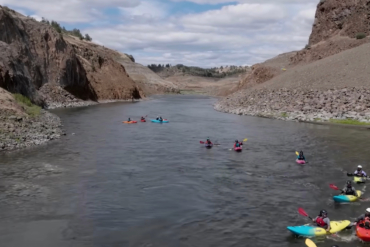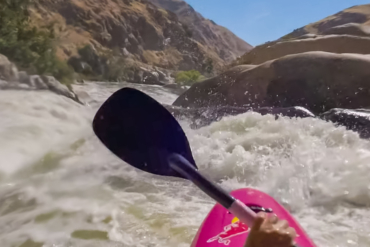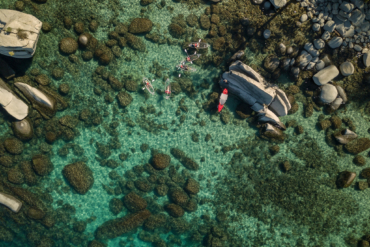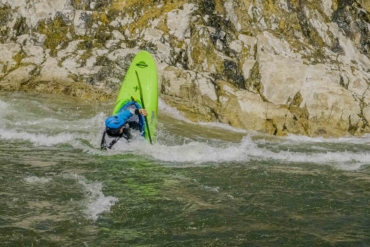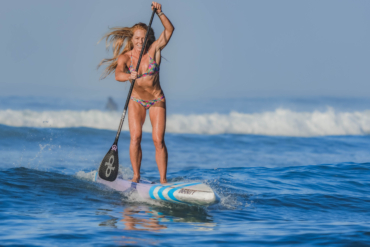A giant, custom-made raft was piloted down the Grand Canyon last week. Its crew pushed for more than 39 hours straight set on breaking a record.

Paddling the 277-mile length of the Colorado River’s Grand Canyon is a lifetime goal for whitewater enthusiasts. Last week, an elite team tried to complete the whole stretch in one go.
In a magnificent 48-foot craft a crew including members of the U.S. Whitewater Rafting Team set out from Lee’s Ferry, Ariz., late at night on January 13th.
What unfurled ahead was a dark river, currents rushing around 20,000 cfs, cliffs towering above. Through the night they rowed, eight men who’d spent a year training and designing a one-of-a-kind craft.

As reported in a great recap in the Denver Post, there was to be “No stopping. No bathroom breaks. No sleeping.” Then, disaster struck after the team had been rowing non-stop for more than 20 hours.
At the Colorado River’s massive Lava Falls rapid a frame-bar snapped, puncturing one of the inflatable beams and effectively ending the trip. A futile effort to repair the boat was aborted and the crew then faced “nine hours of dejected flatwater paddling below Lava,” as the Post article explains.
In the end, the trip took 39 hours and 24 minutes. They went straight through, with no sleep and few breaks, and they did not break the record. But the team — Jeremiah Williams, John Mark Seelig, Robbie Prechtl, Kurt Kincel, Seth Mason, Matt Norfleet, Ian Anderson, and Marty Borges — was proud of its effort and the experimental boat that got them there.

We caught up with the crew’s Ian Anderson for a quick recap and a breakdown on some of the gear.
Congrats on your mission, even though it may not have ended like you’d planned. Tell us about the boat!
We built a custom cataraft frame around two 48-foot tubes from Jack’s Plastic Welding. The frame has six rowing positions and a 12-foot-long, rear-mounted oar that is used as a tiller for steering. The main body of the frame is 24-feet-long and has 4-foot extensions extending forward and backward at each corner to stiffen up the tubes a bit.
The frame is made from a combination of aluminum and carbon composite tubing from Cataract Oars. We mounted six sliding seats to two square aluminum rails that ran the length of the frame. The seat assemblies were from Concept 2 rowing machines, with an NRS tractor seat mounted on top. We also mounted Concept 2 foot stretchers on plywood boards at each rowing station.
One of the most impressive pieces of gear we used were the Dreissigacker Racing Oars. These are super lightweight carbon fiber oars designed for sculls racing on flatwater, and we weren’t sure how they would do if we bashed them into rocks or pulled on them in massive whitewater. We brought four extra with us just in case. We didn’t need them. They performed awesomely.
To let you paddle at night it had some insane lighting, correct?
We mounted a 20″ KC HiLiTES LED light bar and four 3″ LED flood lights in the front of the boat for a total of about 11,000 lumens of maximum output. We wired the lights with waterproof switches so we could switch between low beams (3,200 lumens), high beams (7,600 lumens), or both. We customized a waterproof ammo can to hold a 100-pound, 284 Amp Hour marine battery to power the lights. A 100-watt flexible solar panel recharged the battery for our second night in the Canyon.
Tell the readers about your gear in general.
We wore NRS Navigator drysuits with Smartwool merino layers underneath. We had on NRS Zen lifejackets and lightweight Black Diamond Vapor Helmets with waterproof BD Icon headlamps. We wore Chaco Outcross shoes. Suunto Ambit 3 watches helped us track our speed and distance.
A waterproof, Bluetooth Braven speaker provided tunes, which we desperately needed rowing 40 miles of flatwater at the end. Two YETI 65 Tundra Coolers doubled as food storage and seats in the back of the boat. A Paco Pad on top of the coolers provided a place to lay down for quick cat naps.
We used Sawyer water bottles with a filter for hydration and scooped water straight out of the river. We had custom mesh bags built to hold food and water at each rowing station.
There were lightweight tents and sleeping bags from Big Agnes in case we had to bivy. We had a Jetboil stove to heat water (which came in handy when we needed to heat up a tube patch).

What did you eat?
For food, we ate a ton of Honey Stinger chews and bars, homemade date balls, bacon, PBJ sandwiches, fried chicken fingers, and self-heating Omeals, which were awesome when we were cold.
We had every variety of caffeine delivery including Voke Tabs, Yerba Mate, Cokes, cold brew coffee, and Red Bull.
How did you get roped into this adventure?
I used to be a raft guide and an avid paddler, though I don’t get out on the water as much as I used to. I’ve been friends with the guys on the U.S. National Rafting Team for years and they were looking for a new footwear sponsor. When we signed Chaco as a client at Backbone Media, I connected them and they signed a partnership in 2015.

In subsequent conversations, the team mentioned their interest in making an attempt at the Grand Canyon record and Chaco was immediately excited to support it. In January of last year, Seth Mason on the team pulled a permit for January 13, 2017, and then it all became very real. The team asked me if I’d like to join them, and I jumped at the chance.
How did you train for this?
My teammate Seth and I in Carbondale worked with a Gym Jones trainer, Carolyn Parker, who built us an awesome training plan. The guys in Vail worked with John Mark Seelig, another member of our team, who also owns a Gym Jones gym called GOAT.
We did a lot of intervals and weight training and I had a Concept 2 rowing machine at home. I’d row for an hour or two a few nights a week and then row longer on the weekends. I caught up on a lot of TV while sitting on a rower last fall.
What was your low and high moment on the trip?
The highlight for me was running Hermit. It has some of the biggest waves in the Grand Canyon and we hit them head on. I was sitting in the front of the boat facing backward, and the boat got nearly vertical hitting some of the waves. I was looking down on the guys driving and their facial expressions were unforgettable.
The low point was getting briefly stuck on a rock in Killer Fang Falls, one of the very last rapids in the Canyon. It was still dark, we were pretty demoralized and exhausted, and we just blew our line. We had to get everyone off the boat onto a rocky, slippery riverbank to free up the boat. I thought for sure we were going to put another hole in the tubes or break the frame further. Thankfully it held together.

How long did it take to recover?
Uhh, I’ll tell you next week. Or next month maybe.
Will you try it again?
It’s too soon to answer that just yet. Some of the guys are talking about it, or maybe shooting for a 24-hour distance record instead. Getting a Grand Canyon permit is pretty tough, so that will be a limiting factor.
What would you guys do differently next time?
I think we might consider making the boat a bit smaller. It’s tough to steer a 48-foot raft moving with a lot of momentum through big whitewater.
The flat water paddle after the breakdown sounded insane. Pretty tough to get to the end?
For sure, there are 40 miles of pure flatwater at the end of the trip, with a pretty strong headwind. We all just wanted to be done, but we had almost six hours of rowing left. We had music and plenty of junk food to see us through to the end.
–See a recap of the trip on DenverPost.com as well as the post “Grand Canyon Speed Record Attempt.”


